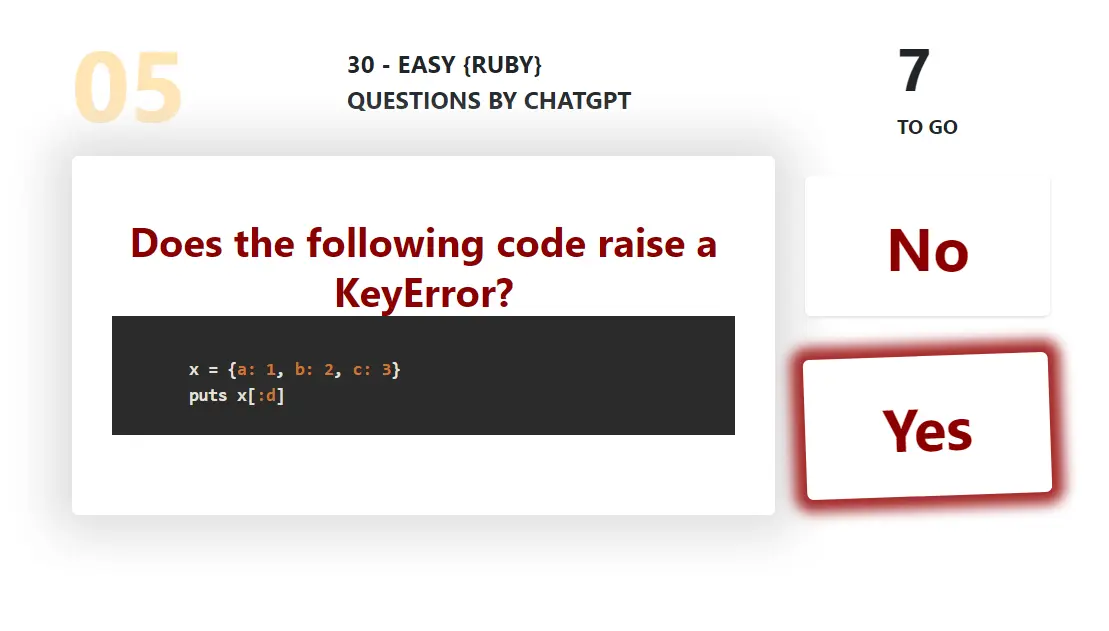
🐍 Top 20 Python Interview Questions and Answers for 2025 20/07/2025 ~ Views: 1062
1. What are Python’s key features?
- Interpreted
- High-level
- Dynamically typed
- Object-oriented
- Extensive standard library
- Platform independent
2. What is the difference between a list and a tuple?
- list is mutable, tuple is immutable
- list has more methods, slightly slower due to mutability
- Use tuple when data should not change
3. What is a dictionary in Python?
An unordered, mutable collection of key-value pairs.
Defined with {}, keys must be immutable (e.g., strings, numbers, tuples).
Defined with {}, keys must be immutable (e.g., strings, numbers, tuples).
4. What is list comprehension?
A concise way to create lists:
squares = [x**2 for x in range(10)]
5. What is the difference between is and ==?
- == checks value equality
- is checks object identity
a = [1,2]; b = [1,2] a == b → True a is b → False
6. **What are *args and kwargs?
- *args collects positional arguments into a tuple
- **kwargs collects keyword arguments into a dictionary
7. What is a Python generator?
A function that yields values one at a time using yield, saving state between calls.
Efficient for large datasets.
Efficient for large datasets.
8. What is the difference between @staticmethod and @classmethod?
- @staticmethod: no access to class or instance (self or cls)
- @classmethod: receives class (cls) as first argument
9. What is the Global Interpreter Lock (GIL)?
A mutex in CPython that allows only one thread to execute Python bytecode at a time.
Limits multi-threaded performance.
Limits multi-threaded performance.
10. What is the difference between deep copy and shallow copy?
-
Shallow copy copies object references
-
Deep copy copies everything recursively
Use copy.copy() and copy.deepcopy()
11. What is Pythonic code?
Code that follows idiomatic Python conventions:
Readable, clean, uses list comprehensions, unpacking, EAFP, etc.
Readable, clean, uses list comprehensions, unpacking, EAFP, etc.
12. What is the difference between range() and xrange()?
- Python 3: xrange() is removed
- range() returns an iterable (like xrange() did in Python 2)
13. What is the difference between a module and a package?
-
Module: a single .py file
-
Package: a folder with __init__.py and other modules
14. Explain duck typing in Python.
“If it walks like a duck and quacks like a duck, it’s a duck.”
Python cares about behavior (methods), not type.
Python cares about behavior (methods), not type.
15. What are Python decorators?
Functions that modify behavior of another function or method.
Example:
Example:
@my_decorator def hello(): pass
16. What is the difference between del, remove(), and pop()?
- del deletes by index or variable
- remove() deletes by value
- pop() removes and returns item by index
17. What are Python’s data types?
- Numeric: int, float, complex
- Sequence: list, tuple, range
- Mapping: dict
- Set: set, frozenset
- Boolean: bool
- Text: str
18. What is the difference between None and False?
- None is the absence of a value (null)
- False is a Boolean
None != False, but both are falsy in conditionals
19. What is the with statement used for?
Context manager. Automatically handles setup and teardown (e.g., closing files):
with open('file.txt') as f:
data = f.read()
20. What is the difference between __str__() and __repr__()?
- __str__() → user-friendly string
- __repr__() → unambiguous developer-focused string (can recreate object if possible)
📘 Want to Ace Your Python Interviews?
These 20 questions are just the beginning.
We created a full guide with 60+ Python questions, complete with code examples, explanations, and bonus behavioral prep.
We created a full guide with 60+ Python questions, complete with code examples, explanations, and bonus behavioral prep.
🎁 Download Free Sample – Python Interview Handbook
📚 Get the Full Book Now – Python Interview Handbook
📚 Get the Full Book Now – Python Interview Handbook
✅ Includes:
- Beginner to advanced questions
- Real company interview patterns
- Practice tasks + solutions
Find more interviewing ebooks on interviewbible.com
Tags: #pythonebook #pythoninterview #pythonjobs








